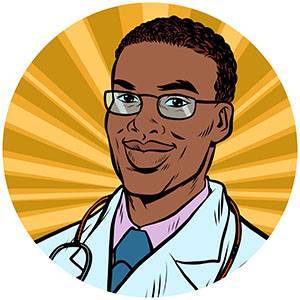Let's Talk About Your Testosterone Levels
Low testosterone affects millions of men worldwide, with symptoms that can significantly impact daily life. Sadly, too many men are afraid to discuss anything to do with anything related to penis issues, sexual function, or emotional health. Let’s get over that and have a serious discussion about testosterone.
Are you experiencing unexplained fatigue, decreased muscle mass, or a diminished sex drive? These could be signs of low testosterone, a condition that often goes unrecognized but is completely treatable. In this comprehensive guide, we’ll explore:
- The telltale symptoms that might indicate low testosterone
- Natural and medical treatment options backed by science
- Lifestyle changes that can help boost your testosterone levels
- When to seek professional medical help
Whether you’re just starting to notice changes or have been struggling with symptoms for some time, understanding low testosterone is the first step toward reclaiming your vitality and overall well-being. Let’s dive into everything you need to know about diagnosis, treatment, and long-term management.
Key Takeaways
- Low testosterone is diagnosed when levels fall below 300 ng/dL, with normal ranges being between 300-1,000 ng/dL for adult males.
- Common symptoms include decreased sex drive, reduced muscle mass, fatigue, and changes in mental health, which can significantly impact daily functioning.
- Treatment options range from natural remedies like lifestyle modifications and vitamin D supplementation to medical interventions such as testosterone replacement therapy.
- Regular blood tests and consultation with a healthcare provider are essential for accurate diagnosis and monitoring of testosterone levels.
- Risk factors include chronic diseases, obesity, alcohol dependence, and certain medical conditions like Klinefelter syndrome and primary hypogonadism.

Identifying Low Testosterone Symptoms
Low testosterone can manifest through various physical and emotional changes that significantly impact daily life. Understanding these symptoms is crucial for early detection and proper treatment.
Physical Symptoms
When testosterone levels drop, several noticeable physical changes occur in the body. One of the most common symptoms of low testosterone is a decrease in sex drive, making intimate relationships challenging. Men may experience reduced muscle mass and increased body fat, particularly around the midsection. Physical stamina diminishes, leading to low energy levels and frequent fatigue.
- Other physical indicators include:
- Loss of body and facial hair
- Decreased bone density
- Difficulty building muscle despite regular exercise
- Hot flashes
- Changes in sleep patterns
- Reduced sperm count
Psychological Symptoms
The impact of low testosterone extends beyond physical changes, affecting mental and emotional well-being. Many men experience mood swings and irritability, which can strain relationships with family and friends. Depression becomes more common, often accompanied by:
- Difficulty concentrating
- Memory problems
- Lack of motivation
- Decreased self-confidence
- Anxiety
- Mental fatigue
These psychological symptoms can create a cycle where low energy and mood issues compound each other, making it harder to maintain regular activities and exercise routines.
The combination of physical and psychological symptoms can significantly impact quality of life, making it essential to seek professional medical evaluation if multiple low testosterone symptoms are present.
💡 Key Takeaway: Low testosterone manifests through both physical changes like reduced sex drive and muscle mass, and psychological symptoms including mood swings and depression, significantly impacting overall well-being.
Common Causes and Risk Factors
The development of low testosterone can stem from various factors affecting the body’s hormone production system. Understanding these causes is crucial for proper diagnosis and treatment.
Primary Causes
Primary hypogonadism occurs when there’s direct damage or dysfunction of the testicles. This condition can arise from several possible causes, including genetic disorders like Klinefelter syndrome, physical injury to the testicles, or complications from mumps infection. Chemotherapy and radiation treatments for cancer can also significantly impact testicular function, leading to reduced testosterone production.
Secondary Causes
Secondary hypogonadism involves problems with the brain’s signaling system that controls testosterone production. This type of low testosterone often develops due to chronic diseases such as obesity, diabetes, or HIV/AIDS. Other contributing factors include certain medications, particularly opioid painkillers and steroids, as well as pituitary gland disorders that disrupt hormone regulation.
Sleep disorders like sleep apnea can also trigger hormonal imbalances that affect testosterone levels. Additionally, aging naturally leads to a gradual decline in testosterone production, with levels typically decreasing by about 1% annually after age 30.
Environmental factors and lifestyle choices play significant roles too. Exposure to endocrine-disrupting chemicals, excessive alcohol consumption, and chronic stress can all impact testosterone production. Poor diet and lack of exercise can further compound these issues, especially when combined with other risk factors.
💡 Key Takeaway: Low testosterone can result from direct testicular damage (primary causes) or disrupted hormone signaling (secondary causes), with various factors like chronic diseases, medications, and lifestyle choices contributing to its development.

Natural Ways to Boost Testosterone
If you’re looking to boost testosterone levels without turning to synthetic treatments, you’re in the right place. A surprising number of lifestyle and dietary choices have a direct impact on your body’s natural hormone production. From how you move and sleep to what you eat and how you manage stress, small shifts can make a big difference.
Let’s explore practical, natural strategies—rooted in everyday habits—that support healthy testosterone levels and help you feel more energized, focused, and resilient.
Lifestyle Changes
Making strategic lifestyle adjustments can naturally enhance testosterone levels. Regular exercise, particularly resistance training and high-intensity interval training (HIIT), stimulates testosterone production. For overweight male individuals, losing excess weight through consistent physical activity can significantly improve hormone balance.
Getting adequate sleep is crucial, as testosterone production peaks during deep sleep cycles. Aim for 7-9 hours of quality rest each night. Managing stress levels through meditation, yoga, or other relaxation techniques helps reduce cortisol, which can interfere with testosterone production.
Spending time outdoors and getting natural sunlight exposure helps your body produce vitamin D, a vital nutrient for testosterone synthesis. If you live in a less sunny climate, consider vitamin D supplementation.
Dietary Modifications
Your diet plays a crucial role in regulating hormones. Contrary to popular belief, following a low-fat diet isn’t ideal for testosterone production. Include healthy fats from sources like olive oil, avocados, and nuts in your meals. Eating penis-positive foods will help with every aspect of your sexual wellness.
Focus on consuming adequate protein from lean meats, fish, and plant-based sources. Include zinc-rich foods like oysters, beef, and pumpkin seeds in your diet. Minimize your intake of processed foods and sugar, as they can negatively impact your hormone levels.
Consider incorporating foods rich in vitamin D, such as fatty fish, egg yolks, and fortified dairy products, into your diet. Stay well-hydrated and maintain a balanced diet with plenty of fruits, vegetables, and whole grains to support overall hormonal health.
💡 Key Takeaway: Natural testosterone enhancement involves a combination of targeted lifestyle changes and proper dietary choices, focusing on exercise, quality sleep, stress management, and balanced nutrition rich in essential nutrients.

Medical Treatment Options
For men diagnosed with clinically low testosterone, medical treatment can offer significant relief from symptoms and restore hormonal balance. Testosterone Replacement Therapy (TRT) is the most widely used intervention, available in various forms to suit different lifestyles and preferences. Whether administered through injections, gels, patches, or long-acting pellets, TRT aims to bring testosterone levels back to a healthy range.
In this section, we’ll explore the primary types of medical therapy available and highlight the importance of proper monitoring to ensure both safety and effectiveness.
Types of Therapy
Testosterone replacement therapy (TRT) stands as the primary medical intervention for men with clinically low testosterone levels. This hormone replacement therapy comes in several forms, each tailored to individual needs and preferences.
Injectable testosterone remains one of the most common and cost-effective options. Administered every 1-2 weeks, these injections provide consistent hormone levels when properly scheduled. Testosterone gels offer a daily application method, absorbed through the skin for steady hormone delivery throughout the day.
Testosterone patches provide another transdermal option, typically applied nightly to maintain hormone levels. For longer-term treatment, pellets can be inserted under the skin, releasing testosterone gradually over 3-6 months.
Monitoring and Side Effects
Any testosterone-boosting treatment requires careful medical supervision. Regular blood tests monitor hormone levels, ensuring they stay within the therapeutic range while checking for potential complications.
Healthcare providers typically schedule follow-up appointments every 3-6 months during the first year of treatment. These visits include assessments of prostate health, blood cell counts, and overall response to therapy.
Common side effects of hormone replacement therapy may include:
- Acne or oily skin
- Sleep apnea
- Breast enlargement
- Reduced sperm production
- Increased risk of blood clots
Some men might experience fluid retention or changes in cholesterol levels. It’s crucial to report any unusual symptoms to your healthcare provider promptly.
The success of treatment often depends on consistent monitoring and adjusting the therapy as needed. Your doctor will work with you to find the right balance between managing symptoms and minimizing side effects.
💡 Key Takeaway: Medical treatment for low testosterone primarily involves various forms of replacement therapy, requiring careful monitoring and management of potential side effects under professional medical supervision.
Conclusion
Understanding and addressing low testosterone is essential for maintaining not just energy and mood, but also sexual wellness, reproductive health, and overall physical vitality. Low testosterone can impact libido, erectile function, sperm production, penis firmness, and even the health of penile tissue—making it a key factor in both daily comfort and long-term well-being.
By recognizing the signs early and choosing the right path—whether through lifestyle changes, natural strategies, or medical therapy—you can take proactive steps toward restoring hormonal balance. Everybody is different, so finding a personalized approach that works for you is critical.
Low testosterone doesn’t have to define your health journey. With informed choices and the right support, you can reclaim your strength, improve your sexual wellness, and live fully with confidence and vitality.

FAQs
Yes, low testosterone can significantly impact fertility and sperm production. The male reproductive system needs adequate testosterone levels for proper sperm development. Men with low T often experience reduced sperm count and quality, which can make conception more challenging.
Yes, low testosterone can impact how often you can ejaculate. Testosterone plays a key role in regulating libido, sexual performance, and energy levels. When testosterone levels are low, you may experience a decrease in sexual desire, reduced frequency of spontaneous erections, and less overall motivation for sexual activity. These changes can naturally lead to ejaculating less often. In some cases, low testosterone can also contribute to erectile dysfunction or difficulty reaching orgasm, which further reduces the likelihood or frequency of ejaculation. If you’re noticing significant changes, it’s worth discussing with a healthcare provider.
Masturbating does not have a significant long-term impact on your testosterone levels. While there may be slight, short-term hormonal fluctuations immediately after ejaculation, research shows that these changes are temporary and don’t affect your baseline testosterone.
Regular masturbation doesn’t lower testosterone, nor does abstaining from it significantly boost your levels over time. What influences testosterone more substantially are factors such as sleep, stress, diet, exercise, and overall health. So, unless your self-pleasure time is interfering with other aspects of your life, it’s unlikely to have any meaningful effect on your testosterone.
In other words, feel free to spank that monkey whenever the mood hits!
Yes, testosterone levels naturally decline with age, typically by about 1-2% annually after age 30. However, the rate of decline varies among individuals. Some men maintain healthy levels well into their senior years, while others experience significant drops earlier in life.
Absolutely. Chronic stress increases cortisol levels, which can suppress testosterone production. Poor sleep quality disrupts hormone production cycles, including testosterone. Getting 7-9 hours of quality sleep and managing stress can help maintain healthy testosterone levels.
Many supplements claim to boost testosterone. We recommend Testosil.
Unlike synthetic hormone treatments that can come with harsh side effects, Testosil is made with clinically studied ingredients designed to help your body stimulate testosterone production. With powerful elements like KSM-66® ashwagandha, fenugreek, D-aspartic acid, and vitamin D3, it aims to restore hormonal balance, increase vitality, and improve both physical and mental performance.
The supplement is produced in a cGMP-certified facility in the USA and is free of artificial additives, making it a clean option for those prioritizing health and wellness.
Whether you’re aiming to improve your gym performance, sharpen your focus, or simply feel like your energized self again, Testosil could be a supportive step toward reclaiming your edge.
Generally, TRT is a long-term treatment as stopping it can cause testosterone levels to drop again. However, the duration depends on the underlying cause of low T. Some men may need lifelong therapy, while others might require it temporarily if their condition improves with lifestyle changes.
Most men notice initial improvements in mood and energy within a few weeks of starting treatment. However, significant changes in muscle mass, bone density, and sexual function typically take 3-6 months. Full benefits may not be apparent until after 6-12 months of consistent treatment.





